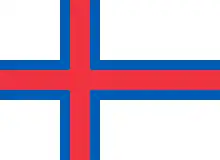The Faroe Islands Portal The Faroe or Faeroe Islands (/ˈfɛəroʊ/ FAIR-oh), or simply the Faroes (Faroese: Føroyar, pronounced [ˈfœɹjaɹ] ⓘ; Danish: Færøerne [ˈfeɐ̯ˌøˀɐnə]), are an archipelago in the North Atlantic Ocean and an autonomous territory of the Kingdom of Denmark. The official language of the country is Faroese, which is closely related to and partially mutually intelligible with Icelandic. Located 320 kilometres (200 mi) north-northwest of the United Kingdom, the islands have a total area of about 1,400 square kilometres (540 sq mi) with a population of 54,676 as of August 2023. The terrain is rugged, and the subpolar oceanic climate (Cfc) is windy, wet, cloudy, and cool. Despite the northerly climate, the temperatures are moderated by the Gulf Stream and average above freezing throughout the year, hovering around 12 °C (54 °F) in summer and 5 °C (41 °F) in winter. As a result of its northerly latitude and proximity to the Arctic Circle, the islands experience perpetual civil twilight during summer nights and very short winter days. The capital and largest city, Tórshavn, receives the fewest hours of sunshine of any city in the world at a mere 840 per year. While archaeological evidence points to earlier human habitation, Færeyinga Saga and the writings of Dicuil place initial Norse settlement in the early 9th century. As with the subsequent Settlement of Iceland, the islands were mainly settled by Norwegians and Norse-Gaels, who additionally brought thralls (i.e. slaves or serfs) of Gaelic origin. Between 1035 and 1814, the Faroe Islands were a territory of the Kingdom of Norway, which was in a personal union with Denmark from 1537, having previously previously been part of the Kalmar Union since 1397. Having gradually come under de facto Danish rule, the Faroes were formally transferred to Denmark In 1814 by the Treaty of Kiel as part of Norway's Atlantic territories alongside Greenland and Iceland, while Norway was transferred to Sweden. Following the establishment of an official Faroese orthography by Vencesclaus Ulricus Hammershaimb, Danish was gradually displaced by Faroese as the language of government, public education and law from the late 19th to the early 20th century. The islands were occupied by the British during the Second World War, who refrained from governing Faroese internal affairs: inspired by this period of relative self-government and the declaration of Iceland as a republic in 1944, the islands held a referendum in 1946 that resulted in a narrow majority for independence. The results were annulled by Christian X, and subsequent negotiations led to the Faroe Islands being granted self-rule in 1948 as a compromise. While remaining part of the Kingdom of Denmark to this day, the Faroe Islands have extensive autonomy and control most areas apart from military defence, policing, justice and currency, with partial control over its foreign affairs. Because the Faroe Islands are not part of the same customs area as Denmark, they have an independent trade policy and are able to establish their own trade agreements with other states. The islands have an extensive bilateral free trade agreement with Iceland, known as the Hoyvík Agreement. In the Nordic Council, they are represented as part of the Danish delegation. In certain sports, the Faroe Islands field their own national teams. They did not become a part of the European Economic Community in 1973, instead keeping autonomy over their own fishing waters; as a result, the Faroe Islands are not a part of the European Union today. The Løgting, though suspended from 1816 to 1852, holds a claim as one of the oldest continuously-running parliaments in the world. One Faroe Islander, Niels Ryberg Finsen, has won the Nobel Prize; due to the country's small population, the Faroe Islands resultingly hold the most Nobel laureates per capita. (Full article...) Selected article -The Church of the Faroe Islands (Faroese: Fólkakirkjan, lit. 'people's church'; Danish: Færøernes folkekirke) is one of the smallest state churches in the world. Prior to becoming independent on 29 July 2007, it was a diocese of the Church of Denmark, a Lutheran church. As of 2023, 77.0% of the Faroe Islanders belonged to the state church. Other churches in the Faroe Islands include the Plymouth Brethren and the Roman Catholic Church. (Full article...)Selected picture -Things you can do
Geography stubs · People stubs · Sports clubs stubs · Faroese stubs in general
Help us categorize Faroe Islands-related articles
Have a look at WikiProject Faroe Islands, WikiProject Denmark, WikiProject Greenland and WikiProject Norse history and culture Related portalsGeneral imagesThe following are images from various Faroe Islands-related articles on Wikipedia.
SubcategoriesCategory puzzle Select [►] to view subcategories
Faroe Islands Faroe Islands-related lists Buildings and structures in the Faroe Islands Faroese culture Economy of the Faroe Islands Education in the Faroe Islands Environment of the Faroe Islands Geography of the Faroe Islands Government of the Faroe Islands Health in the Faroe Islands History of the Faroe Islands Organizations based in the Faroe Islands Faroese people Politics of the Faroe Islands Society of the Faroe Islands Faroe Islands stubs Did you know...
Wikipedia in Faroese
Faroe Islands topicsAssociated WikimediaThe following Wikimedia Foundation sister projects provide more on this subject:
Discover Wikipedia using portals
|

.JPG.webp)











_in_October.jpg.webp)



